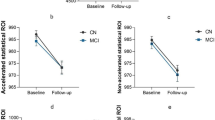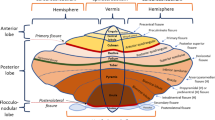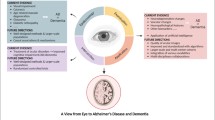Abstract
High-tension glaucoma (HTG) is one of the most common forms of primary open angle glaucoma. The purpose of this study was to assess in HTG brain, whether the elevated intraocular pressure (IOP) had an effect on the brain morphological alterations via structural MRI. We acquired T1WI structural MRI images from 56 subjects including 36 HTG patients and 20 healthy controls. We tested whether the brain morphometry was associated with the mean IOP in HTG patients. Moreover, we conducted moderation analysis to assess the interactions between subject type (HTG - healthy controls) and IOP. In HTG group, cortical thickness was negatively correlated with the mean IOP in the left rostral middle frontal gyrus, left pars triangularis, right precentral gyrus, left postcentral gyrus, left superior temporal gyrus (p < 0.05, FDR corrected). Four of the five regions negatively correlated with mean IOP showed reduced cortical thickness in HTG group compared with healthy controls, which were the left rostral middle frontal gyrus, left pars triangularis, left postcentral gyrus and left superior temporal gyrus (p < 0.05, FDR corrected). IOP moderated the interaction between subject type and cortical thickness of the left rostral middle frontal gyrus (p = 0.0017), left pars triangularis (p = 0.0011), left postcentral gyrus (p = 0.0040) and left superior temporal gyrus (p = 0.0066). Elevated IOP may result brain morphometry alterations such as cortical thinning. The relationship between IOP and brain morphometry underlines the importance of the IOP regulation for HTG patients.



Similar content being viewed by others
References
Giorgio A, Zhang J, Costantino F, et al. Diffuse brain damage in normal tension glaucoma. Hum Brain Mapp. 2018;39:532–41.
Kwon YH, Fingert JH, Kuehn MH, et al. Primary open-angle glaucoma. N Eng J Med. 2004;363:1711.
Yi W, Weizhao L, Tingqin Y, et al. Functional MRI reveals effects of high intraocular pressure on central nervous system in high-tension glaucoma patients. Acta Ophthalmol. 2019;97:e341–e8.
King D, Drance SM, Douglas GR, et al. Comparison of visual field defects in normal-tension glaucoma and high-tension glaucoma. Am J Ophthalmol. 1986;101:204–7.
Sommer A. Intraocular pressure and glaucoma. Am J Ophthalmol. 1989;107:186–8.
Chauhan BC, Drance SM. The influence of intraocular pressure on visual field damage in patients with normal-tension and high-tension glaucoma. Invest Ophthalmol Vis Sci. 1990;31:2367–72.
Lawlor M, Daneshmeyer H, Levin LA, et al. Glaucoma and the brain: trans-synaptic degeneration, structural change and implications for neuroprotection. Surv Ophthalmol. 2018;63:296–306.
Adachi M, Takahashi K, Nishikawa M, et al. High intraocular pressure-induced ischemia and reperfusion injury in the optic nerve and retina in rats. Graefes Arch Clin Exp Ophthalmol. 1996;234:445–51.
Dai H, Morelli JN, Ai F, et al. Resting-state functional MRI: functional connectivity analysis of the visual cortex in primary open-angle glaucoma patients. Hum Brain Mapp. 2014;34:2455–63.
Frezzotti P, Giorgio A, Toto F, et al. Early changes of brain connectivity in primary open angle glaucoma. Hum Brain Mapp. 2016;37:4581–96.
Brambilla P, Hardan A, di Nemi SU, et al. Brain anatomy and development in autism: review of structural MRI studies. Brain Res Bull. 2003;61:557–69.
Frisoni GB, Fox NC, Clifford RJ Jr, et al. The clinical use of structural MRI in Alzheimer disease. Nat Rev Neurol. 2010;6:67–77.
Frezzotti P, Giorgio A, Motolese I, et al. Structural and functional brain changes beyond visual system in patients with advanced glaucoma. Plos One. 2014;9:e105931.
Jiang MM, Zhou Q, Liu XY, et al. Structural and functional brain changes in early- and mid-stage primary open-angle glaucoma using voxel-based morphometry and functional magnetic resonance imaging. Medicine. 2017;96:e6139.
Chen WW, Wang N, Cai S, et al. Structural brain abnormalities in patients with primary open-angle glaucoma: a study with 3T MR imaging. Invest Ophthalmol Vis Sci. 2013;54:545–54.
Wang J, Li T, Sabel BA, et al. Structural brain alterations in primary open angle glaucoma: a 3T MRI study. Sci Rep. 2016;6:18969.
Yu L, Xie L, Dai C, et al. Progressive thinning of visual cortex in primary open-angle glaucoma of varying severity. PLoS ONE. 2015;10:e121960.
Dahnke R, Yotter RA, Gaser C. Cortical thickness and central surface estimation. Neuroimage. 2013;65:336–48.
Yotter RA, Dahnke R, Gaser C. Topological correction of brain surface meshes using spherical harmonics. Hum Brain Mapp. 2011;32:1109–24.
Potvin O, Dieumegarde L, Duchesne S. Freesurfer cortical normative data for adults using Desikan-Killiany-Tourville and ex vivo protocols. Neuroimage. 2017;156:43–64.
Hammers A, Allom R, Koepp MJ, et al. Three-dimensional maximum probability atlas of the human brain, with particular reference to the temporal lobe. Hum Brain Mapp. 2010;19:224–47.
Hayes A. Introduction to mediation, moderation, and conditional process analysis. J Educ Meas. 2013;51:335–7.
Toothaker LE. Multiple regression: testing and interpreting interactions. J Oper Res Soc. 1994;45:119–20.
Li C, Cai P, Shi L, et al. Voxel-based morphometry of the visual-related cortex in primary open angle glaucoma. Curr Eye Res. 2012;37:794–802.
Born RT, Tootell RBH. Segregation of global and local motion processing in primate middle temporal visual area. Nature. 1993;365:497–9.
Gazzard G, Foster PJ, Devereux JG, et al. Intraocular pressure and visual field loss in primary angle closure and primary open angle glaucomas. Br J Ophthalmol. 2003;87:720–5.
Iacoboni M, Woods RP, Lenzi GL, et al. Merging of oculomotor and somatomotor space coding in the human right precentral gyrus. Brain. 1997;120:1635–45.
Paus T. Location and function of the human frontal eye-field: a selective review. Neuropsychologia. 1996;34:475–83.
Tehovnic EJ, Sommer MA, Chou I, et al. Eye fields in the frontal lobes of primates. Brain Res Rev. 2000;32:413–48.
Ni Z, Gunraj C, Nelson AJ, et al. Two phases of interhemispheric inhibition between motor related cortical areas and the primary motor cortex in human. Cereb Cortex. 2009;19:1654–65.
Potkin SG, Turner JA, Brown GG, et al. Working memory and DLPFC inefficiency in schizophrenia: the FBIRN study. Schizophr Bull. 2009;35:19–31.
Viswanathan P, Nieder A. Comparison of visual receptive fields in the dorsolateral prefrontal cortex (dorsolateral prefrontal cortex) and ventral intraparietal area (VIP) in macaques. Eur J Neurosci. 2017;46:2702–12.
Blatt GJ, Andersen RA, Stoner GR. Visual receptive field organization and cortico-cortical connections of the lateral intraparietal area (area LIP) in the macaque. J Comp Neurol. 1990;299:421–45.
Anzai A, Peng X, Van Essen DC. Neurons in monkey visual area V2 encode combinations of orientations. Nat Neurosci. 2007;10:1313–21.
Johnson PB, Ferraina S, Bianchi L, et al. Cortical networks for visual reaching: physiological and anatomical organization of frontal and parietal lobe arm regions. Cereb Cortex. 1996;6:102–9.
Funding
This study was supported by the Taishan Scholars Program of Shandong Province (Grant number: TS201712065), Academic Promotion Program of Shandong First Medical University (Grant number: 2019QL009), Natural Science Foundation of Shandong Province (Grant number: ZR2023QH109), and Science and Technology funding from Jinan (Grant number: 2020GXRC018).
Author information
Authors and Affiliations
Corresponding authors
Ethics declarations
Conflict of interest
L. Jing, T. Yan, J. Zhou, Y. Xie, J. Qiu, Y. Wang and W. Lu declare that they have no competing interests.
Additional information
Data Accessibility statement
The data of this study are available upon reasonable request from corresponding authors.
Supplementary Information
62_2023_1351_MOESM1_ESM.docx
Supplementary Tables 1–4 Results of the moderation analysis investigating IOP as a moderator of the association between subject type (HTG-HC) and cortical thickness of the left rostral middle frontal gyrus, left pars triangularis, left postcentral gyrus, left superior temporal gyrus.
Rights and permissions
Springer Nature or its licensor (e.g. a society or other partner) holds exclusive rights to this article under a publishing agreement with the author(s) or other rightsholder(s); author self-archiving of the accepted manuscript version of this article is solely governed by the terms of such publishing agreement and applicable law.
About this article
Cite this article
Jing, L., Yan, T., Zhou, J. et al. Elevated Intraocular Pressure Moderated Brain Morphometry in High-tension Glaucoma: a Structural MRI Study. Clin Neuroradiol 34, 173–179 (2024). https://doi.org/10.1007/s00062-023-01351-6
Received:
Accepted:
Published:
Issue Date:
DOI: https://doi.org/10.1007/s00062-023-01351-6




